Of all the historical boats in the world, those built by the Vikings are the ones that capture my heart. From the 9th-century Gokstad ship, and the small boats found with it, to the 21st-century DRAKEN HARALD HÅRFAGRE, there is nothing more atmospheric for me: The shape of the hulls, the upswept ends, and even the building methods fascinate me. I’m a regular visitor to the website of the Viking Ship Museum in Roskilde, Denmark, and watch the museum’s videos of traditional boats being built and sailed. I have followed the Skuldelev excavations and reconstructions at the museum and read numerous books about their construction. A series of articles by Jean-Pierre Guillou in Maritime Life and Traditions magazine detailed the history and construction of the Norwegian faering and introduced me to the book Inshore Craft of Norway by Bernard Færøyvik. This led me, in 2012, at the start of retirement, to the idea of building my own faering.
I had been building boats, as an amateur, since the late 1980s, and had five double-enders under my belt. Færøyvik’s book was filled with line drawings of boats that he surveyed along the coast of Norway in the early 20th century. Of all these designs, the Sunnhordland faering was the most appealing to me. It was built around 1935 by Johan Slettskog of Onarheim, on Norway’s southwest coast. It was 18′ 11″ long, 5′ 4 1⁄2″ wide, and had just three very wide strakes.
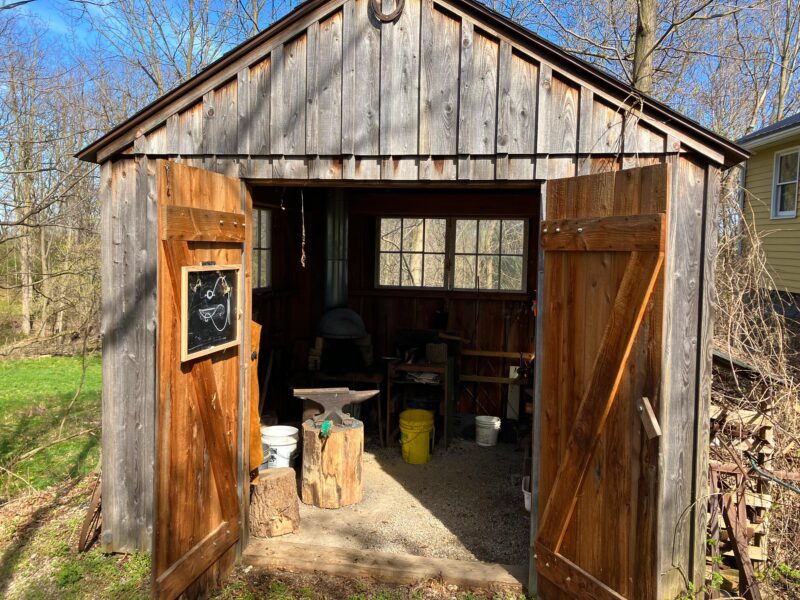 Craig Hohm
Craig HohmI wanted a Viking axe, so I built this forge and made one prototype. Then I quickly decided to go with conventional tools for building the faering.
I intended my faering project to be as traditional in build as feasible—riveted lapstrake with minimal framing. Watching the ship-reconstruction videos on the Roskilde museum’s website, I was fascinated by the planks split radially from logs, curved frames cut from grown crooks, and the work achieved by simple tools, especially the axes. Another major inspiration was Roar’s Circle, by Henrik Juel, which chronicles the construction by a bunch of amateur volunteers of a replica of one of the five 11th-century Skuldelev wrecks. I got it into my head that I needed an axe like the ones they used, but after finding they cost more than $500, I ended up making a timber-frame building for a forge and filled it with the tools I’d obtained from a derelict blacksmith shop in northern Pennsylvania. I have yet to make that axe, but the forge has been handy for making other gear.
Staying with the idea of tradition, I decided to source wood from trees that I could harvest and from logs awaiting sawing at small local mills. Knowing it might take a couple of years to get the stock together, I began looking for the lumber the faering would require.
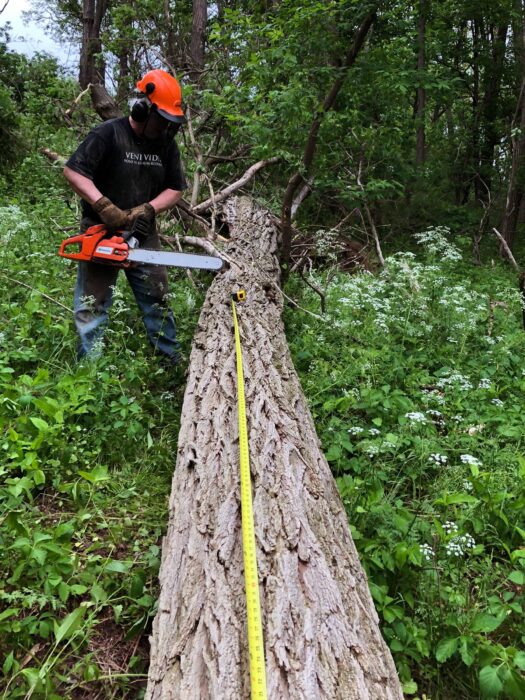 Sue Hohm
Sue HohmI felled the biggest locust tree in my woodlot. I shudder to think of the number of stupid things I did when I was learning about tree cutting. I am privileged to be alive.
In the U.K. larch is often used for planking, and there is plenty of it growing in upstate New York where I live. I had asked one mill owner to keep an eye out for good larch logs, and he found me two that were 14′ long, 20″ diameter; one with a sweep of 18″ in curve along its length. These were flitch sawn on the curve and produced about 300 board feet in total at a cost of only $0.80/bf. These boards were stickered in my 19th–century timber-frame barn where they joined the other 2,000+ bf of hardwoods that I’d harvested and milled over the past 30 years. Much of this wood I will never use, but it is there for my son and others, as sure a treasure hoard as any found in a Viking barrow grave.
Black locust is another superior boatbuilding wood and, as people around here say, it lasts about 20 years longer than rock. Some years ago, I cut down a locust from the 20-acre lot at my home. It was 24″ diameter, 30′ to the first branches, 80′ high, and straight. I wanted it for framing and keel stock. By decree, I am required to have my wife, Sue, with me when I cut trees like this, and she dutifully stood, cellphone in hand (to call 911) as it came down without issue. I hauled a 12′ section out of the woodlot with the tractor, and with a combination of rollers, cant hooks, and tractor power, managed to get it on the trailer to take to my friend Rob Ringer for milling.
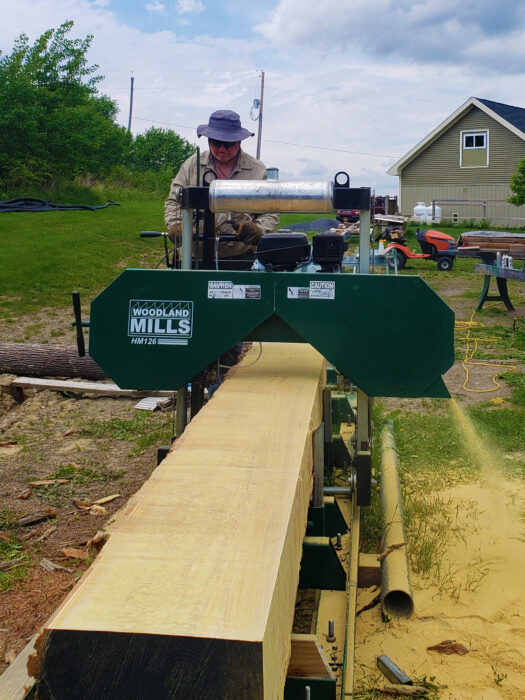 Rob Ringer
Rob RingerRob’s sawmill has a 9.5-hp engine and a 22′ capacity. It doesn’t propel itself, so here I’m pushing it along its rails. Rob agrees that the fresh-cut locust wood smells like sneakers; to be exact, a 14-year-old boy’s sneakers.
This was a big log, by Rob’s estimate weighing about 1,900 lbs. Why bother with this when I could go to a local sawmill and get white oak? For me it was not about the money. It was about the idea of making it myself, not just the boat but the materials, the self-sufficiency, the adventure. And there is the ultimate satisfaction of knowing the boat was built from wood from my property. So, Rob and I levered the log with peaveys up onto the bed of his gas-powered horizontal bandsaw mill and slabbed it up. The mills made little fuss gliding along on rails cutting at about 1″ per second. We sawed some as 4⁄4 lumber and about a third as 8⁄4, the widest about 20″ with no knots. The wood smells like sneakers and is a faint greenish color when cut but takes on a honey-yellow color when dry. When finished with a coating of pine tar and linseed oil, it has almost a cherry color. I have heard people complain about locust dulling their tools, but I can’t say that was ever apparent to me. Tools regularly need sharpening no matter what the wood, and I find marine ply to be harder on edges. The freshly milled locust boards were heavy, but I got them stickered in the barn to air-dry.
Faerings, meaning four-oared boats, are little changed in their basic shape and construction in the last 1,000 years. They have three main frames and two canted frames, called stammerings or rangs, one in each end, all made of crooks. I knew I was not going to be able to find grown crooks, but I was fortunate to run across Adrian Osler’s book, The Shetland Boat. In the 1800s, boats in Shetland were very similar in hull form to the Norwegian faerings; some were even built in Norway, taken apart, and shipped to Shetland as kits. Those boats were made with sawn frames instead of frames from crooks, and, fortunately for me, the book described their construction in detail and served as a guide for scantlings, structural details, and sail dimensions.
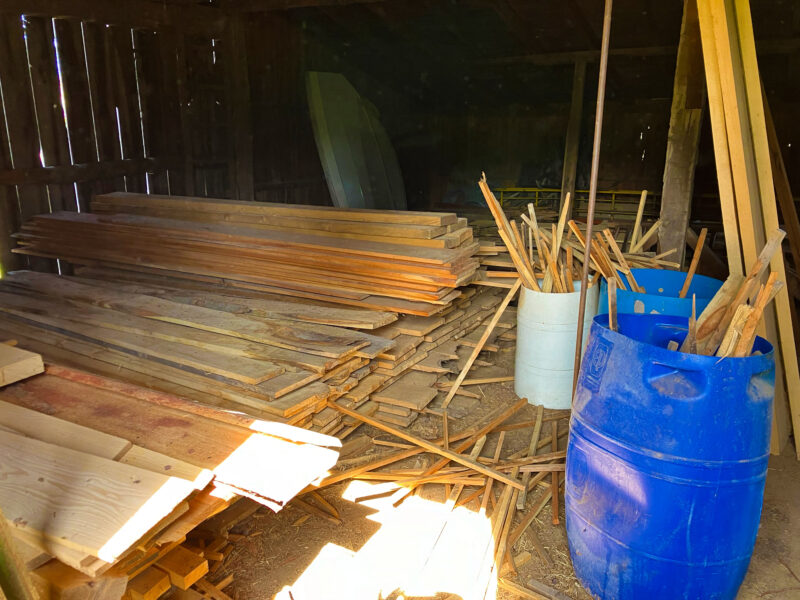 Craig Hohm
Craig HohmMy hoard of wood has grown over the 30 years I have been buying lumber from local mills, have had mills come to my woodlot, or from select pieces I’ve inherited from friends. I even have exotic jarrah wood from an old hot tub.
I lofted the Sunnhordland faering from the drawings in Færøyvik’s book. There were no offsets, and the plan and profile views of the boat were only 4 1⁄4″ long so I had to increase their size on my copier until the dimensions fit my architect’s rule. Then I drew it 1:10 scale and measured that drawing for offsets. I put inexpensive lauan plywood on the floor of my shop and painted it white. My scaled-up offsets were accurate enough that the full-sized loft required little tweaking.
Prior to buying my place in 1985, I had not been a woodworker (aside from making a cutting board in 8th grade). The house was built in the 1850s and close by was another old building that the seller, a builder, had used as a shop to build cabinets. The first time I walked in there, I saw a lapstrake mahogany Barnegat Bay sneakbox that he had just finished, and I said, “Where do I sign?” The shop has an L-shaped layout, and the main bay with a garage door at either end is 40′ × 16′; there is a 14′ × 14′ side room where my power tools live on wheels. It has a wooden floor, ideal for lofting and backbone setups. The walls are lined with workbenches and all the hand tools are ready at hand.
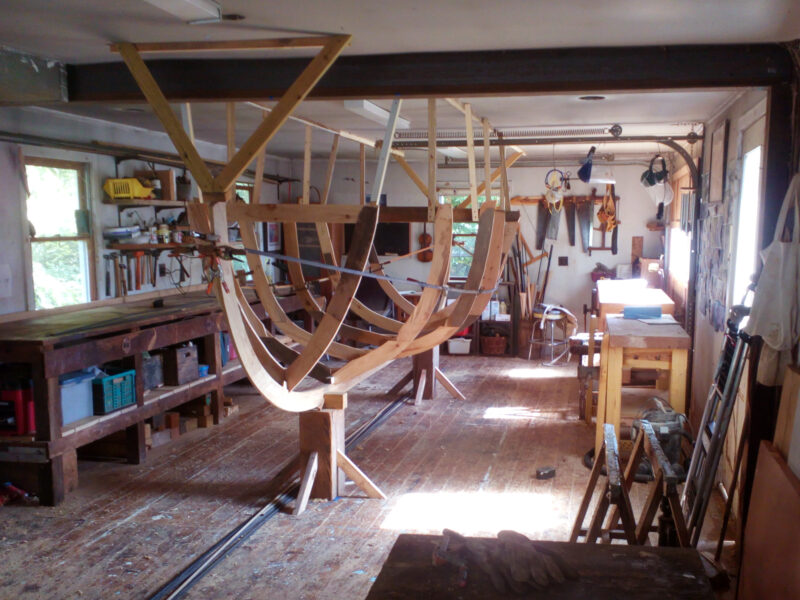 Craig Hohm
Craig HohmAfter I set the keel and stems up on the strongback, I glued the scarfs between them and then glued the horizontal T cross-section of the keel. In traditional construction, these would be short scarfs (about 1:4) nailed with tar in the joint, and I would have carved the T-shaped keel with that axe I’d planned to make.
I built the faering upright, in the traditional manner, but with six molds mounted on the keel and braced with cross spalls and struts to the ceiling. The old-timers did not use molds but rather had a system of measuring each plank-face angle relative to plumb using a simple protractor, the batlodd. I’ve read that all the information needed to build a boat could be reduced to a few measurements on a stick…that, and the contents of the builder’s head.
I didn’t have larch boards wide enough for the original Sunnhordland faering’s three strakes, so I went for five. Most of the internal structure was based on Shetland methods, using sawn frames in lieu of grown crooks. Iain Oughtred reassured me that the traditional method of beveled plank ends landing on and screwed to an un-rabbeted stem would be strong and durable.
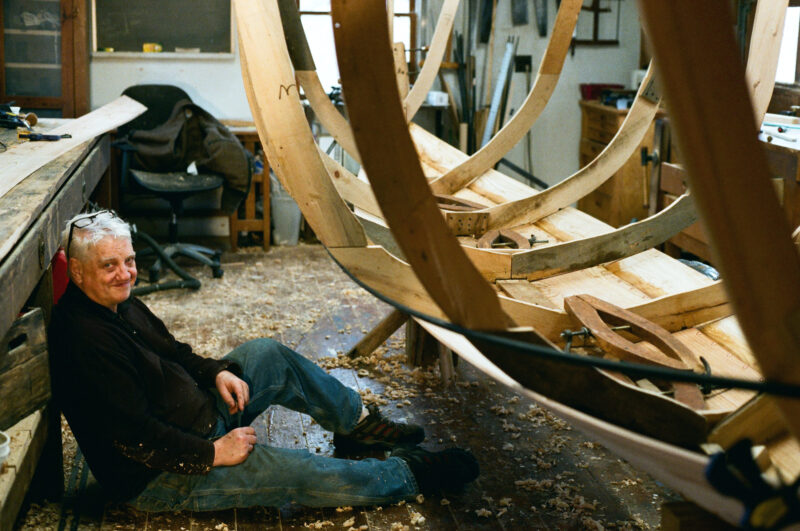 Sue Hohm
Sue HohmIn the corner of the workshop is my moaning chair where I would sit when I had done something boneheaded, holding my bony head in my hands and moaning. This moment of repose didn’t require the chair.
My one nod to modern materials was to scarf the planks with epoxy, rather than seal them with tar and fasten them with clench nails or rivets. I am sure if epoxy was available 1,000 years ago, the Vikings would have raided for it, along with marine plywood. Even after increasing the number of strakes, I had to joint some boards and epoxy them edge-to-edge to have planking stock wide enough for some of the upper strakes. I did the glue-ups prior to thickness-planing the stock to 1⁄2″. I used up that larch in its entirety.
I sealed the laps with thickened pine tar cooked to the consistency of honey in a deep-fat fryer from the thrift shop. I got that idea from the DRAKEN HARALD HÅRFAGRE book. Real pine tar has a wonderful smell, distinctly nautical with notes of adventure. The tar in the laps was overlaid with wool yarn. The laps were closed with square-shanked copper rivets and conical roves.
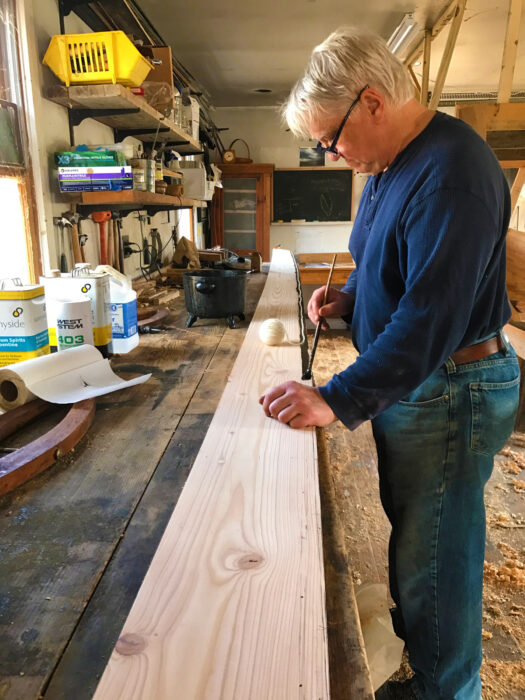 Sue Hohm
Sue HohmAs I painted hot tar along the lap, I laid a strand of wool in the sticky black stripe, and it would stay put during riveting. It is a traditional method that, I would later learn, leads to leaky seams, which are equally traditional. I could have gone with thicker wool, or for that matter, I could have used some contemporary commercial goop.
I was used to building hulls upside down, which works well with glued-lap plywood. Building the faering upright made it possible, while working alone, to buck the rivet heads on the outside with one hand and peen the heads over the roves on the inside with the other. The work was tedious and noisy. I wore hearing protectors—ear goggles as we call them here. The lap rivets were placed 4″ apart.
After the third strakes were in place, I fit the lower portion of the frames and fastened them to the planking with locust trunnels, wedged with the growth rings perpendicular to the long grain of the frame. The trunnels are 5⁄8″ in diameter and I turned them on my mini lathe, after splitting the stock out with an axe. (The head design was originally a conical section that swelled to 7⁄8″ and was flush outside, but I found after the first season that the trunnels tended to pull through the plank when the wood soaked up—the lateral expansion of the planking wood stretched them out. I was interested to learn that in the original Viking ships, the frames below the waterline were tied into raised cleats on the plank with withies, which allowed the planks to move without straining the fastenings. So, the next year I pulled the lower frames out and redid the trunnel heads into a dome shape with the head raised above the outside planking.)
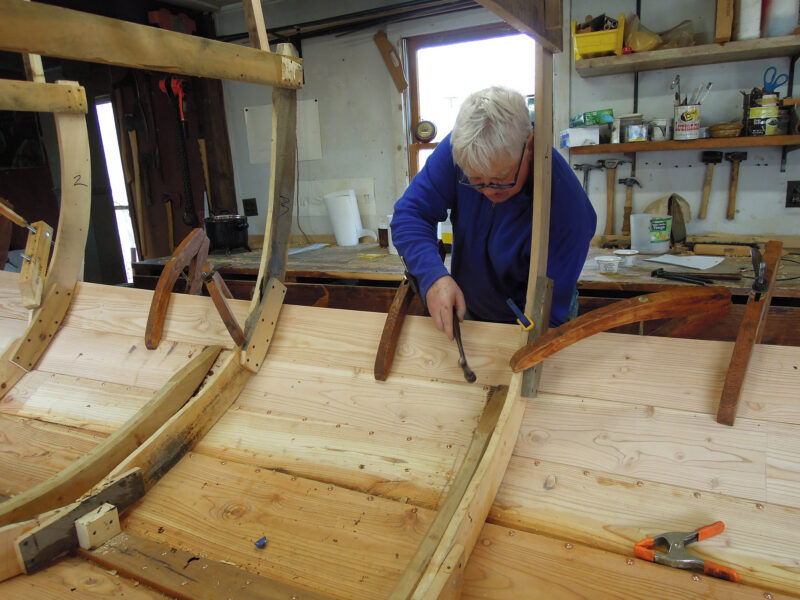 Sue Hohm
Sue HohmTap tap tap tap tap. Each of the square-shank copper rivets took more than 50 hits to flare it over its rove. It was nice to be able to do each plank as it was hung, holding the bucking iron on the outside, rather than riveting the whole boat after planking.
After the top two strakes were in, I extended each frame to the gunwale, then fastened a trunnel through the joint of the top and bottom frame. I found out later that Jay Smith, a boatbuilder who specializes in traditional Nordic boats, does not fasten through this joint, allowing for more flexibility in the hull. In another deviation from tradition, I riveted a crossbeam to the upper frame ends; in the past this beam would have been made of crooks. Their horizontal ends would overlap each other with a scarf joint to form the crossbeam, and the other ends would extend up to the top of the frame. I made each of the canted frames in the bow and stern of glued pieces rather than grown crooks. These frames are a tricky fit over the laps of the planks and pine tar is an excellent marking device, showing the high points where the fit could be improved. Every frame had a limber hole at each lap.
I made the floorboards in four sections to fit between frames, using the Scandinavian transverse orientation of the boards in each section. I used local hemlock I’d stockpiled in the barn. The deep gulleys of New York’s Finger Lakes region where I live are filled with stands of big hemlocks and the wood is moderately rot resistant, like larch but more brittle.
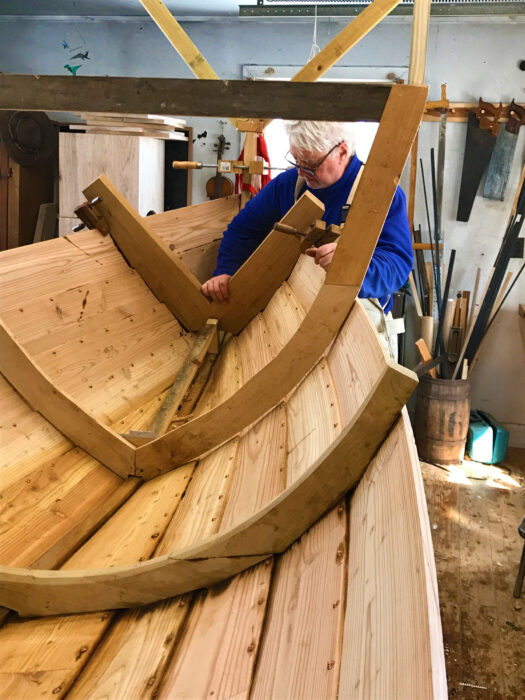 Sue Hohm
Sue HohmFitting the angled rang—a glued V of locust—was a tricky task. I used pine tar to show where the fit touched the planks. The sticky residue would dissolve later when I applied the linseed-oil finish.
The locust outwales are full length, tapering in height and width at the ends. The inwales, also locust, ended at the rangs, and the whole sheer assembly was through-fastened with rivets. Instead of using the traditional kabe oarlocks made from crooks with ropes restraining the oars, I mortised locust crooks into the gunwale and, to keep the oars in place, I installed pins made of pine, meant to break in the event of a serious crab rather than breaking the oar.
I made a pair of 10′ oars from local quarter-sawn spruce, another treasure from my barn cut especially for me from a spruce about 28″ in diameter. They have narrow blades and square-section inboard ends for balance. The distance between rowing positions is an ell, a historic measure about a yard long. In practice this distance is less than in the usual modern rowboat but encourages shorter strokes, perhaps more efficient and less apt to catch a crab. The blades on the oars are quite narrow, as befits a boat used in rough seas.
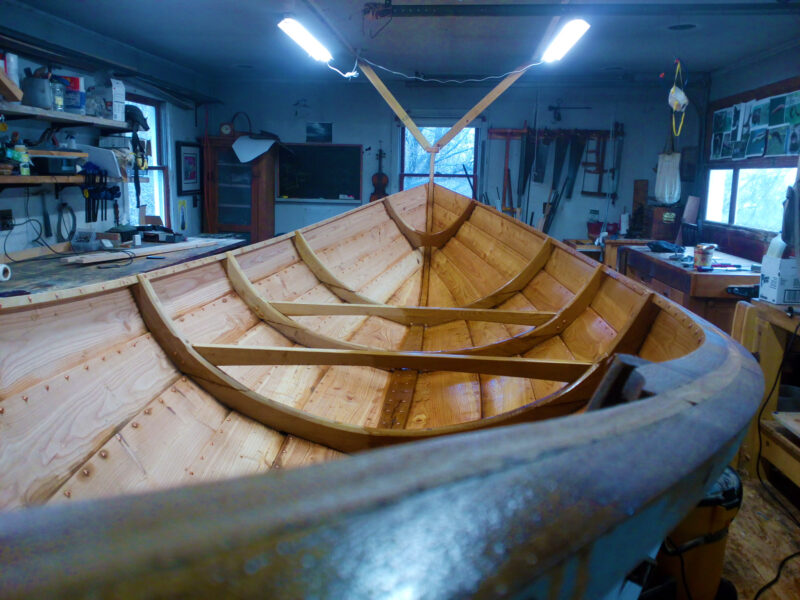 Craig Hohm
Craig HohmThe upper frame extensions had a crosspiece riveted to them above the joint with the lower frame. Here the port side of the hull has been oiled, showing the contrast with the uncoated wood on starboard.
Færøyvik did not offer any indication of a rudder for the Sunnhordland faering, so I adopted a design used in the Shetland boats. The lower pintle on the rudder slides onto a long rod that parallels the curved sternpost to the bottom of the keel. With the long overhang of the aft stem, this makes getting the rudder down to a strong point on the keel easy. To fabricate the fittings, I started by making wax patterns, encasing them in a mold-making material called luto. The wax was then burned out, leaving a space for the bronze to fill. I did the casting with my friend Dexter. The crucible, filled with bronze, weighed 300 lbs, and was lifted out of the sub-floor-level oven by a bridge crane. Pouring the liquid bronze was like pouring lava, and just standing next to the crucible curled the hairs on my legs, even through my Carhartt workpants.
I based the proportions of the sailing rig on diagrams from Osler’s book by measuring the various historical rigs and their relation to each boat’s length and beam. The square rig is not what I’d call practical. Its tack moves forward on the bow for close reaching, back for a broad reach. The yard has a halyard, lines on the clews for sheets and for the tack attachment (which reverse with every tack), a bridled downhaul on the foot of the sail, braces to the yard, and a bowline arrangement on the luff, which also changes with each tack. While its handling is complex and was in time replaced with an asymmetrical square sail, a dipping lug, and ultimately by fore-and-aft rigs like the sprit, I just had to see it on this boat. Using the 1:10 scale drawing, I laid out likely positions on the gunwale to drill holes to serve as the attachment points for the tack and sheet positions.
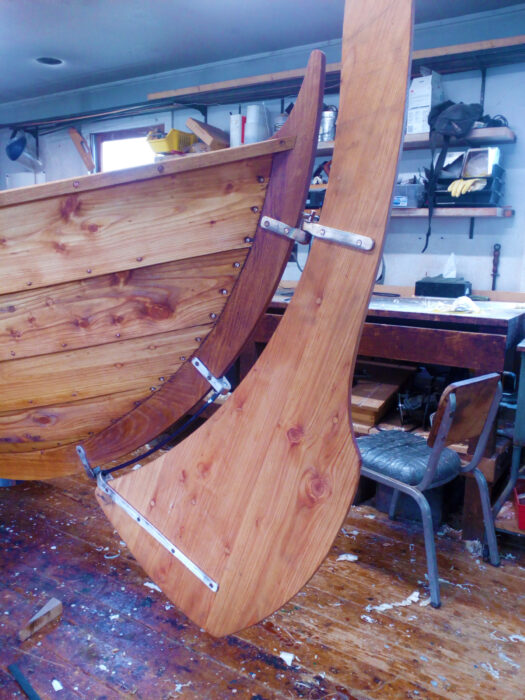 Craig Hohm
Craig HohmA bronze rod runs between the middle gudgeon and the bottom one. The lower pintle on the rudder is a fork that fits over a flattened section at the top of the rod. Below that flat spot the fork is trapped by the rod’s unmodified diameter. There needs to be a fair amount of slack in this system since the two fittings are not on the same axis.
I had the 100 sq ft trapezoidal tanbark Dacron sail made by my friend Douglas Fowler, a sailmaker in Ithaca. I gave him the dimensions and he did the rest. It is a practical sail, no tarred manila or sewn cringles, just roped edges, stainless-steel pressed cringles, and three lines of reefpoints. I didn’t want to go overboard on period details here.
I made the mast from a 40′-tall Norway spruce that I had planted 25 years before. In Iain Oughtred’s book on glued-lap construction he wrote about the moral imperative of using wood responsibly, and he promised to plant some trees. Over the years I’ve planted 12,000 locust and Norway spruce trees on my property, which used to be a vineyard. The land would rather be a forest. My county rents out a planter that fastens to a three-point hitch. It allows me to ride behind the tractor and plant at a walking pace. I shaped the mast with the chainsaw mill and broadaxe. I got the mast and the yard out of a 20′ section of trunk.
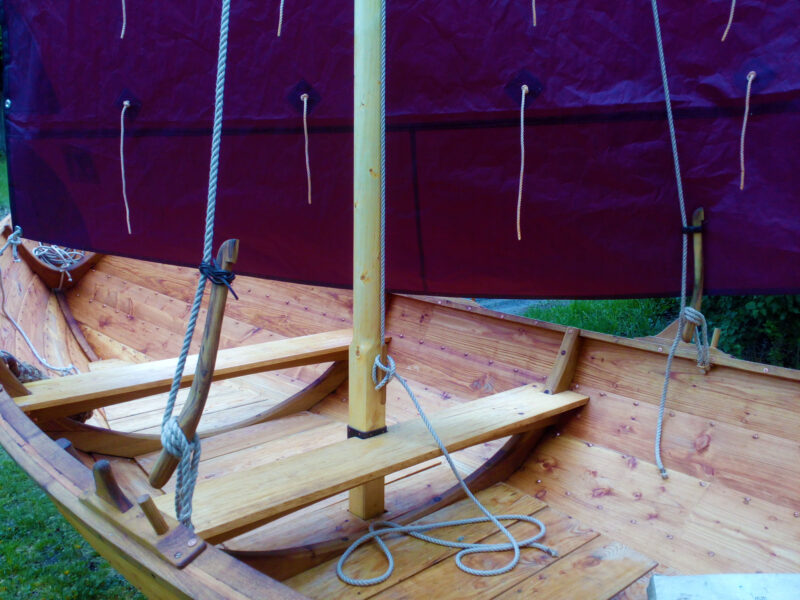 Craig Hohm
Craig HohmThese Viking shroud needles work! I used rawhide Turk’s head knots to capture the needles for the first season and then replaced them with bronze rings. The mast has a step on the keel and a slot in the thwart; the thwart has a loose fit on the frame and is removable.
The mast has a forestay and a shroud on either side tensioned with shroud needles. These needles are locust crooks that have a hole on one end through which the shroud passes; the shaft goes through a rope grommet below the gunwale and levers up to meet the descending shroud like a pelican hook, locking there with a circle of horn or metal. These needles really work, making the shrouds taut. In keeping with the rig, the lines are traditional-looking three-strand Dacron.
I finished all the faering’s wood with a 1:10 mix of pine tar and raw linseed oil. I got these materials from a local firm that imports the real stuff from Scandinavia, the same products used in the DRAKEN HARALD HÅRFAGRE and not the petroleum-based “pine” tar often seen for sale in the U.S.
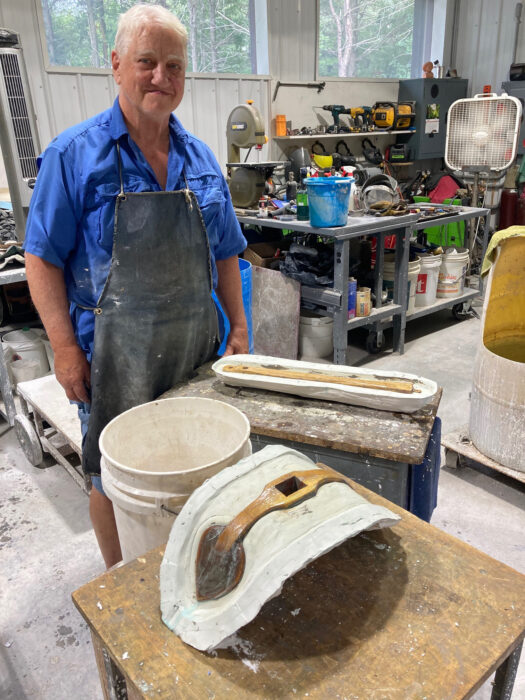 Dexter Benedict
Dexter BenedictIn the midst of making the anchor, I opened the plaster cast to remove the wooden pattern for the flukes. The plaster mold is made in two sections separated by aluminum shims so the mold will come apart cleanly. The shank and its mold are by my left hand. The cross bar is bronze rod with a stopper welded on and an R clip on the other side of the shank to lock it in place. The rectangular hole in the flukes fits a taper at the bottom of the shank.
Finally, I cast a bronze anchor, an 18-lb three-part fisherman’s that breaks down for storage. I made wood patterns, molded them in plaster, and used the molds to make duplicate parts in wax. Those were then cast in molds and the wax was burned out to open a cavity for the molten bronze.
The first day I pulled the faering out in front of the shop, an elderly Finnish woman, whom I had never met, stopped to tell me it looked just like the boats her father built when she was a girl.
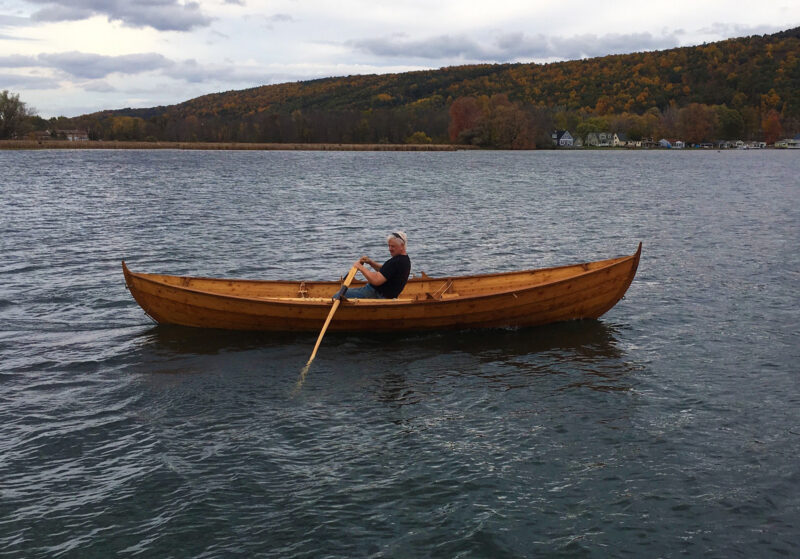 Sue Hohm
Sue HohmThe faering turned out to be a wonderful rower and felt right at home in the fjord-like waters of the west branch of Keuka Lake, one of the smaller of New York’s Finger Lakes.
After two winters of work, I launched the boat in 2016. I admit to some remorse at not using modern goop in the laps below the waterline. If it is launched dry off the trailer, water will be above the floors after about an hour. But then leaking was part of the traditional experience. I’m told the Vikings retired a boat when they had to bail it out more than twice a day.
It is a fabulous rower, and an equally aggravating sailer. It can be sailed solo, but it is, as I said, not practical. You can imagine the mess of lines, and I have yet to train someone to help me with it. It will not come through the wind on a tack, only making about 20 degrees into the wind after leeway. The best way to tack is to lower the sail, and while the bowman is exchanging the luff for the leech, the helmsman rows the bow through the wind. Wearing (coming about by turning away from the wind) is easy but loses ground in the nearly 270-degree turn. I can also tack by backing up to come through the eye of the wind.
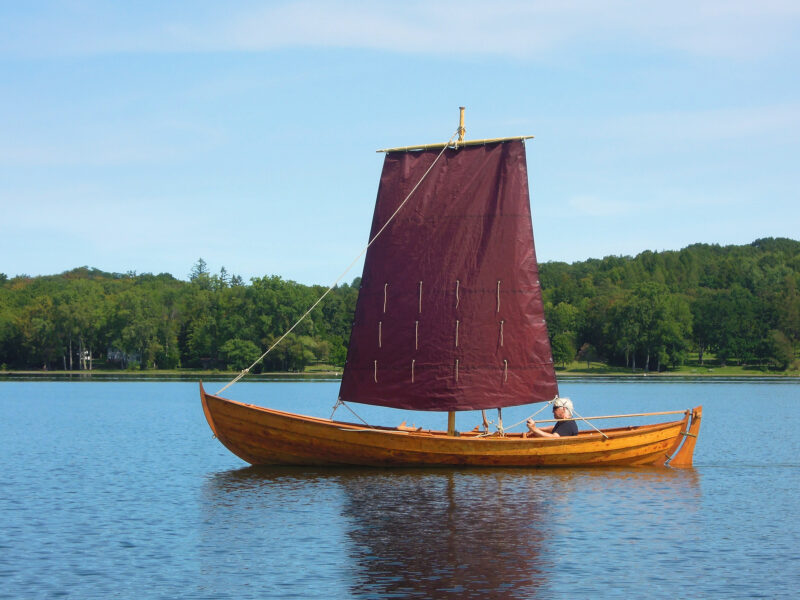 Sue Hohm
Sue HohmAs pleasant as it was to be ghosting along in a gentle breeze, I would have preferred the faering pose for her photo in a wind blowing like stink.
My pine-tar friends asked me to bring the faering to their tent at The WoodenBoat Show at Mystic Seaport in 2017. The boat was a hit, but my wife, unbeknownst to me, had conspired with my family and friends to have them show up wearing red T-shirts emblazoned with “Ask me about Craig Hohm.” I was mortified. I am sure that such TSP (tireless self-promotion) is frowned upon by the Yankee community. (I will get her back; still thinking about the best way.) For all my griping about Sue, never was there such a woman: she encourages me in all these mad capers. Some years ago, I was building a 30-footer and a friend said, “Good Lord, where are you going to put it?” I said I thought it would fit in the barn, but that if it didn’t my wife said we should put up a new building for it. There was a pause and he asked, “May I have her when she is through with you?”![]()
Craig Hohm is a retired emergency doctor and worked for 30 years where the rubber of health care meets the road. He lives in Penn Yan in western New York. Before moving to Penn Yan, he had never been in a sailboat but survived residency by reading books about sailing and boatbuilding. He has six boats currently on the property and is not allowed to sell any of them on the orders of the Warden (wife Sue). He can be found most days between the months of May and October on one of the state’s 11 Finger Lakes. The other months with an R in them are for building. Craig adds, “I owe a lot to Iain Oughtred for years of advice on various topics. May he rest in peace.”
If you have an interesting story to tell about your adventures with a small boat, please email us a brief outline and a few photos.
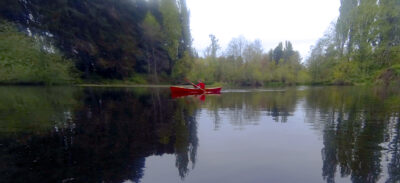

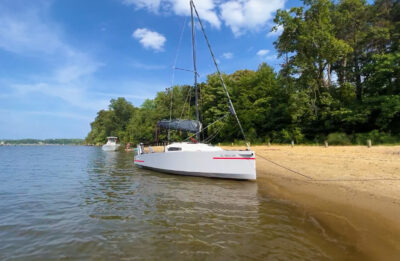
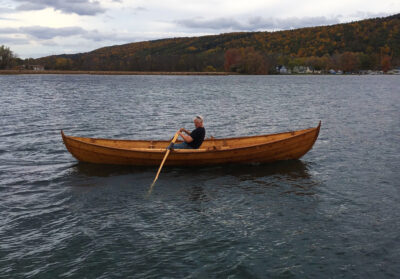
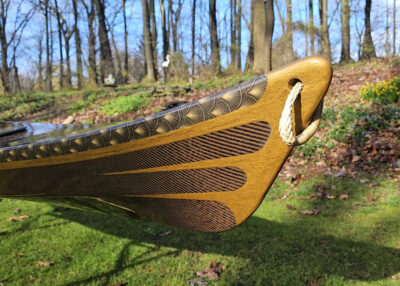
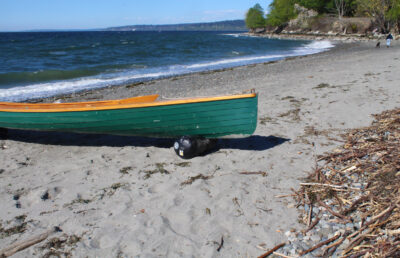
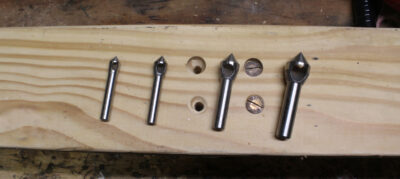
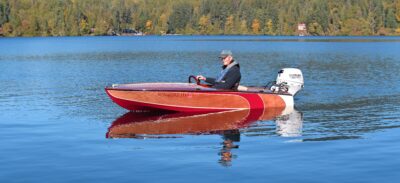
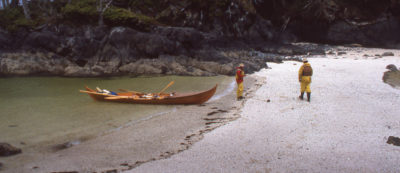
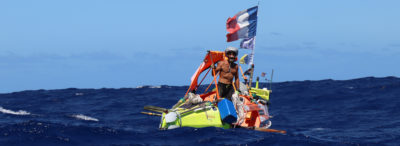


Nice looking boat and I liked the way you sourced materials. It probably would sail better if you had a centerboard or even a lee board. I enjoyed the article very much.
Excellent build and narrative. I’ve been milling my own wood for a boat too. That boat looks like it would go to Valhalla and back again
Well done! I actually own a faering built by Johan Sletteskog. It has three strakes and is 4,95 meters long, inside between the stem and stern at the sheer. It’s rigged whith a sprit sail and also have detachable motor bracket for a 4 hp outboard
That is great. How about a photo?
I don’t have any good digital photos showing the whole boat, but here’s one from a lunch-break rowing and sailing the Hardangerfjord in Western Norway.
The faering was bought by my grand dad in the early 1970’s. When he passed away I inherited it. It’s in good shape, but is currently stored in the barn, to make room in the boathouse for an Oselvar sixoaren. In the boathouse is also an eightoaren owned by my father.
The sixoaren is a pice of art with a interesting history.
Dear Eirik
I am pining for photos of all those boats!